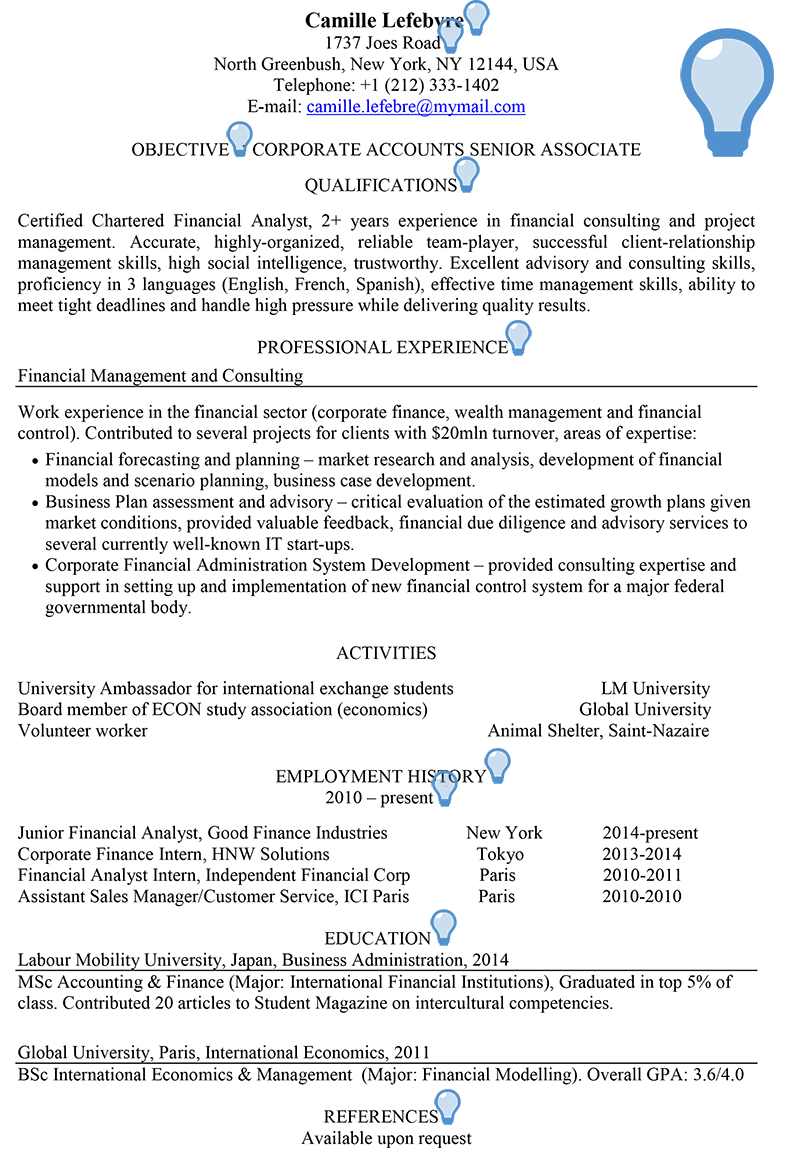USA CV Sample
Click on the light bulbs for valuable tips!

Resume outline
The format of a US resume is different from a European CV. The term “Resume” is used. It is short, typically 1 page, but if you are a more experienced candidate, a maximum of 2 pages, single-sided, is allowed. Note: the US standard paper size is different from A4 (commonly used in Europe); it is called Letter and it is slightly wider and shorter (8.5 x 11 inches).
Personal Details
Include your current address, phone number and e-mail. Do NOT include: profile picture, place/date of birth, nationality, gender, religion, civil status or physical characteristics. US employers consider this information highly-private and sensitive, since it can be used as grounds for discrimination and unfair treatment. If you decide to include this information in the resume, be aware that recruiter might decide not to process your application any longer in fear of potential legal issues.
Objective
State the job title of the position for which you are applying, or, in case of unsolicited applications, include your career goal.
Qualifications
In a few short, powerful sentences describe your skills, specific knowledge and your experience. A resume is a personal ad for an applicant, hence present your achievements in a sharp, focused, upscale manner. Don’t shy away from “overselling”, instead make sure to aggressively advertise yourself!
Professional experience
State the most relevant professional experience for the job requirement, indicating your core areas of expertise and skills that would allow you to perform excellent in this new job. Emphasise your achievements and contributions from previous jobs/internships. If applicable, it is advisable to use tangible/quantitative results to highlight how well your skills helped achieve desired outcome of the project.
Employment History
Use reverse chronological order when listing previous jobs, including name of the company, its location and years of employment. You can also include any internships, leadership positions in student associations or part-time jobs that are relevant to the job requirements.
Providing dates
US resumes are thematic and offer the possibility to show only those qualities and experiences that are important to the vacancy, making them more concise and accurate. It is more narrative in nature, as its sole purpose is to advertise your skills to the recruitment manager, exact dates of education or employment are less detailed when compared to European CVs. Main advantage is that any possible gaps in your employment wouldn’t be too obvious.
Education
List your under- and post-graduate education, including the name of degree/certificate upon completion, dates of attendance and whether you received any honorary or generally note-worthy awards while studying. If applicable, mention major/minor subjects that you have completed. When you are able to quantify your educational achievements (“belonged to the top 5% of my class”) do not hesitate to add this.
References
It is customary to mention at the end of the resume that references are available on request. Especially for foreign job applications it is important to mention them (and bring the references to the interview).
TOP TIP
It is becoming increasingly popular to use the “electronic format” resume for job applications, which is slightly different in format than a standard resume. Introduction and main body of the resume contain many key words that are similar to the words used in the job advertisement. Use nouns instead of action verbs: employers look for skills, job titles, names of schools, companies and products, in short they look for tangible results. This will increase your chances of being selected by HR. The more “hits” on the key words your resume has, the higher the chance that your application will be noticed by the recruiter. Use spacious margins and avoid putting text in italic or bold, as it makes it harder for scanner to identify the word.
